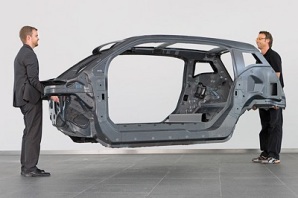onsumption




An age old concern that is now higher on the agenda for manufacturers is overweight vehicles. Traditionally cars have always been made from steel for the structure & ‘body in white’ components, with plastics for trim and other aesthetic and non stressed parts.
The benefits for lighter vehicles are multiple – reduced fuel consumption, emissions, greater performance, and for electric cars greater range which can be a sticking point for potential customers.
Kieron Salter MD of consultancy KW Special Projects, says “lightweighting is a challenge for the two hot areas of chassis & body in white, as well as for the powertrain & other structural components”. New materials with accompanying new manufacturing techniques are often more expensive in general. New emerging companies though can benefit from this new demand, because unlike the established competition they don’t have significant capital investment in traditional production infrastructure and can flex more easily into newer technologies.
The general trend is for a greater use of aluminium, and composites such as carbon fibre already used on more expensive sports cars, which have a high strength to weight ratio. Magnesium and titantium are also being researched & developed – magnesium is 33% lighter than Aluminium and 75% lighter than steel.
New traditional materials are also being introduced, such as ‘low density steel’ – higher strength steels that can be produce lower part volumes and therefore weight. An example of this is being carried out by WMG consultants for Jaguar Land Rover and Aston Martin, known as the Ultran Project. Powertrain gears are being made lighter due to higher strength steels, and new lightweight exhaust systems that are matching the performance of the old ones and are 50% lighter.
With new materials comes new manufacturing challenges and one is the joining process. Aluminium and steel for example cannot be welded together and also there is the problem of galvanic corrosion in service. Companies though such as General Motors have come up with new innovative joining techniques, one of which is using adhesives on their production lines for their Cadillac CT6.
Another exciting move going forward, is the growing relationship between University Research Centres and manufacturers which is moving the automotive industry forward at a pace. Examples of this are: Mclaren and Sheffield University, Meridian Light Weight Technologies and Birmingham City University, and there are many more.
With the growing market share of electric cars the need for car manufacturers to reduce weight is now paramount to entice new customers to the new age of electric, without the stumbling block of low range.
Hope you have a great month
All the best,
Mike
A little light relief
some more alternative exam answers … !


Thanks, Mike
Fascinating as always. Small typo in second para – should say reduced fuel consumption not reduced fuel economy.
John
>
LikeLike
Many thanks John, inglish spilling was never my fortay !!! 🙂
LikeLike